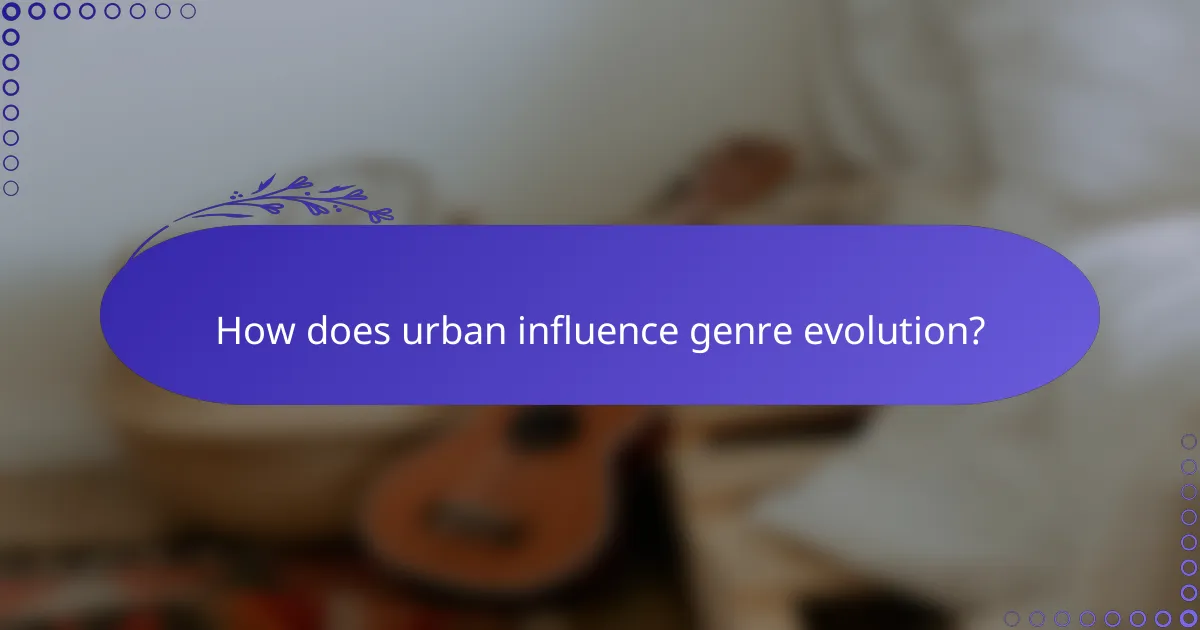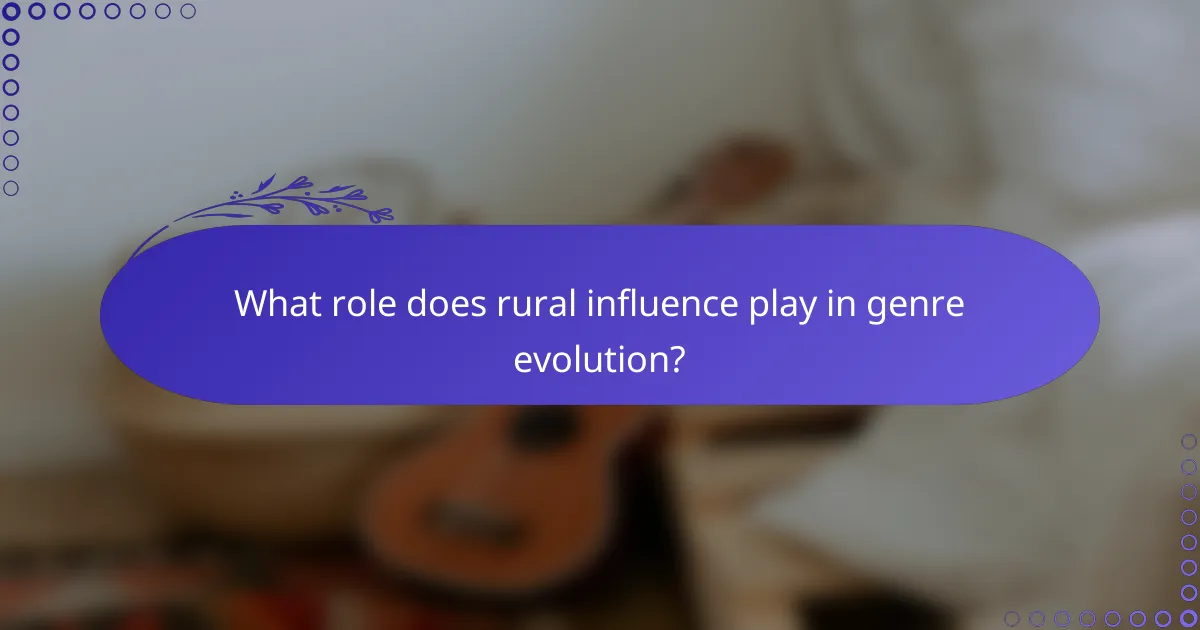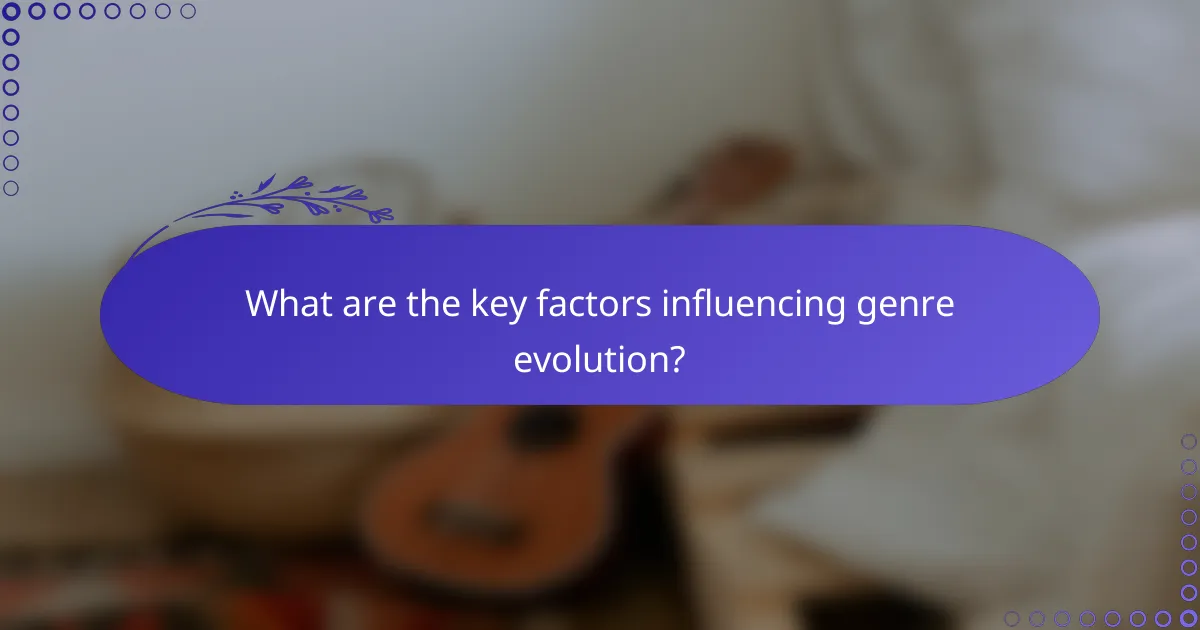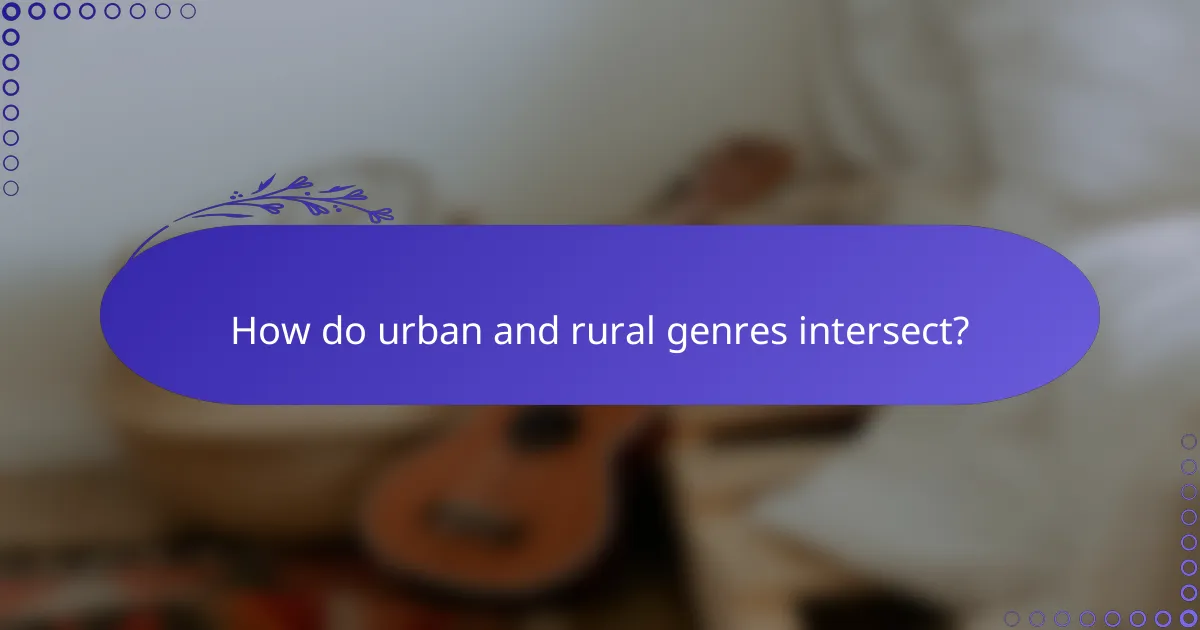The evolution of artistic genres is profoundly influenced by the contrasting environments of urban and rural settings. Urban areas serve as vibrant hubs of cultural exchange and innovation, while rural regions focus on preserving traditional styles and fostering community connections. These differences shape not only the characteristics of the genres but also their reception and relevance to audiences.

How does urban influence genre evolution?
Urban environments significantly shape genre evolution by providing a melting pot of cultural influences, resources, and collaborative opportunities. The dynamic nature of cities fosters innovation and adaptation in various artistic genres, leading to the emergence of new styles and trends.
Access to diverse cultural influences
Urban areas are often characterized by their diversity, bringing together people from various backgrounds and cultures. This mix allows artists to draw inspiration from different traditions, leading to the fusion of genres and the creation of unique sounds or styles. For example, hip-hop has evolved by incorporating elements from jazz, funk, and even traditional music from immigrant communities.
Artists in cities can easily access a wide range of cultural events, festivals, and performances, enhancing their exposure to new ideas. This constant interaction with diverse influences can lead to innovative approaches that redefine existing genres.
Collaboration opportunities among artists
Cities provide numerous opportunities for artists to collaborate, share ideas, and experiment with new concepts. The presence of creative spaces, such as studios and galleries, facilitates partnerships that can result in groundbreaking work. For instance, collaborations between visual artists and musicians often lead to multimedia projects that push the boundaries of traditional genres.
Networking events and artist collectives in urban settings encourage cross-genre experimentation, allowing artists to challenge norms and expand their creative horizons. This collaborative spirit is essential for the evolution of genres, as it fosters a culture of innovation.
Trends driven by urban demographics
The demographics of urban populations play a crucial role in shaping genre evolution. Cities often have younger, more diverse populations that are open to new ideas and trends, which can influence the direction of music, art, and literature. For example, the rise of electronic dance music (EDM) can be attributed to urban youth culture and its embrace of technology and nightlife.
Additionally, urban areas tend to have higher concentrations of resources, such as funding and media exposure, which can amplify emerging trends. Artists who tap into the unique characteristics of their urban environment can create works that resonate with their audience, driving further evolution in their respective genres.

What role does rural influence play in genre evolution?
Rural influence significantly shapes genre evolution by preserving traditional musical styles and fostering community engagement. This connection to local culture and environment creates unique sounds that reflect the experiences and stories of rural life.
Preservation of traditional styles
Rural areas often serve as custodians of traditional music styles, ensuring that these forms are passed down through generations. Genres like folk, bluegrass, and country frequently draw on historical roots, maintaining elements that might otherwise fade in urban settings.
Musicians in rural communities may prioritize authenticity, using acoustic instruments and storytelling lyrics that resonate with their heritage. This dedication helps sustain traditional music, allowing it to evolve while still honoring its origins.
Community-driven music creation
In rural settings, music creation is often a communal activity, with local gatherings and events fostering collaboration among artists. This environment encourages the blending of styles and influences, leading to the development of new genres that reflect the collective identity of the community.
For example, local festivals and jam sessions provide platforms for musicians to experiment and share their work, often resulting in innovative sounds that incorporate various cultural influences, from indigenous rhythms to contemporary genres.
Connection to nature and local stories
Rural music frequently draws inspiration from the surrounding landscape and local narratives, creating a strong sense of place. Themes of nature, agriculture, and rural life permeate the lyrics, making the music relatable to those who share similar experiences.
Artists often weave personal stories and regional folklore into their songs, enhancing the emotional depth and authenticity of their work. This connection not only enriches the music but also strengthens community bonds, as listeners find common ground in shared experiences and histories.

How do urban and rural genres compare?
Urban and rural genres differ significantly in their characteristics, influences, and audience reception. Urban genres often reflect contemporary issues and diverse cultural influences, while rural genres tend to emphasize tradition and local narratives.
Differences in instrumentation and style
Instrumentation and style vary greatly between urban and rural genres. Urban music frequently incorporates electronic elements, synthesizers, and a mix of global influences, resulting in a sound that is often experimental and varied. In contrast, rural genres typically rely on acoustic instruments, such as guitars, banjos, and fiddles, emphasizing a more straightforward and traditional sound.
For example, urban hip-hop might feature heavy beats and sampling from various music styles, while rural folk music often tells stories through simple melodies and harmonies. This distinction shapes the overall listening experience and cultural resonance of each genre.
Audience engagement and reach
Audience engagement and reach differ significantly between urban and rural genres. Urban genres tend to attract a larger, more diverse audience, often facilitated by social media and streaming platforms. This broad reach allows for rapid dissemination of trends and styles, creating a dynamic and ever-evolving musical landscape.
Conversely, rural genres often cultivate a more localized and dedicated fan base. Engagement is typically fostered through live performances in community settings, where personal connections are paramount. This can lead to a strong sense of loyalty among listeners, though the overall audience size may be smaller.
Commercial viability and market trends
Commercial viability for urban and rural genres reflects their differing market trends. Urban genres often see higher sales and streaming numbers, driven by their mainstream appeal and crossover potential into various media. This can lead to lucrative opportunities for artists, including endorsements and collaborations.
Rural genres, while sometimes less commercially successful, can thrive through niche markets and dedicated fan support. Artists in these genres often rely on merchandise sales, local performances, and community events to sustain their careers. Understanding these market dynamics is crucial for artists and producers navigating the music industry.

What are the key factors influencing genre evolution?
Key factors influencing genre evolution include socioeconomic conditions, technological advancements, and media representation. These elements shape how genres develop and adapt over time, reflecting the cultural and contextual landscapes of urban and rural settings.
Socioeconomic conditions
Socioeconomic conditions play a crucial role in genre evolution by affecting the resources available for creative expression. In urban areas, higher population density and greater access to funding can lead to diverse and innovative genres, while rural areas may rely on traditional forms due to limited resources.
For instance, urban centers often see the emergence of new music genres influenced by various cultures, whereas rural communities might preserve folk traditions. Understanding these dynamics can help creators tap into the unique characteristics of their environments.
Technological advancements
Technological advancements significantly impact genre evolution by providing new tools for creation and distribution. Urban areas typically have quicker access to cutting-edge technology, enabling artists to experiment with new sounds and formats, while rural areas may adopt technology at a slower pace.
For example, the rise of digital music production has allowed urban artists to collaborate globally, whereas rural musicians might focus on acoustic performances. This disparity can lead to distinct genre characteristics based on technological access.
Media representation and exposure
Media representation and exposure are vital in shaping public perception and popularity of genres. Urban areas often benefit from greater media coverage, allowing new genres to gain traction quickly. In contrast, rural genres may struggle for visibility in mainstream media.
For instance, urban music scenes often dominate radio and streaming platforms, while rural genres might find their audience through local festivals or niche online communities. This difference in exposure can influence the evolution and acceptance of various genres across different regions.

How do urban and rural genres intersect?
Urban and rural genres intersect through the blending of cultural elements, styles, and influences from both settings. This interaction creates a rich tapestry of music, literature, and art that reflects diverse experiences and perspectives.
Fusion genres emerging from collaboration
Fusion genres arise when artists from urban and rural backgrounds collaborate, combining distinct musical styles or narrative techniques. For example, country-rap blends traditional country music with hip-hop, showcasing influences from both rural storytelling and urban beats.
Collaborative projects often lead to innovative sounds and themes, attracting wider audiences. Artists can leverage their unique backgrounds to create something fresh and appealing, which can resonate across different demographics.
Cross-pollination of influences
Cross-pollination occurs when urban and rural artists share ideas, techniques, and cultural references, enriching their respective genres. This exchange can happen through live performances, social media, or collaborative recordings, allowing for a dynamic flow of creativity.
For instance, urban artists may incorporate folk instruments into their tracks, while rural musicians might adopt electronic elements. This blending not only broadens the appeal of the music but also fosters a sense of community among diverse artists.
Shared themes and narratives
Both urban and rural genres often explore similar themes, such as love, struggle, and identity, albeit from different perspectives. Urban narratives might focus on city life challenges, while rural stories often highlight nature and community ties.
Despite these differences, the underlying emotions and experiences can resonate universally. By addressing shared themes, artists can connect with a broader audience, bridging the gap between urban and rural listeners.
